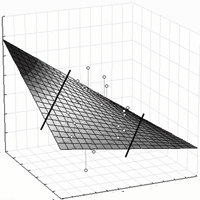
Juvenile growth response of European beech (Fagus sylvatica L.) to sudden change of climatic environment in SE European trials
C Mátyás (1) , G Bozic (2), D Gömöry (3), M Ivankovic (4), E Rasztovits (1)
iForest - Biogeosciences and Forestry, Volume 2, Issue 6, Pages 213-220 (2009)
doi: https://doi.org/10.3832/ifor0519-002
Published: Dec 22, 2009 - Copyright © 2009 SISEF
Research Articles
Collection/Special Issue: COST Action E52 Meeting 2008 - Florence (Italy)
Evaluation of beech genetic resources for sustainable forestry
Guest Editors: Georg von Wühlisch, Raffaello Giannini
Abstract
The aim of the study was to analyse provenance tests of beech situated close to the south-eastern continental limits of the species, in order to develop a response model of adaptation and plasticity of populations on evolutionary-ecological basis, following sudden climatic changes, as a result of transplanting. Modelling of juvenile height was performed with the help of ecodistance variables. The concept of transfer analysis and ecodistance is based on the hypothesis that phenotypic response to macroclimatic changes depends on the inherited adaptive potential of the population and on the magnitude and direction of experienced environmental change. In common garden experiments, the transfer to the planting site is interpreted as simulation of environmental change. The application of ecodistance of transfer for evaluating common garden experiments provides much needed quantitative information about response of tree populations to predicted climatic changes. The analysis of three field experiments of European beech in SE Europe indicates that macroclimatic adaptation patterns exist in juvenile growth and justify restrictions of use of reproductive material on the basis of evolutionary ecology. The presented model illustrates that response to climatic change is regionally divergent, depending on testing conditions and on hereditary traits. In particular, climatic warming in the central-northern part of the range may lead to production increase. However, under the stressful and uncertain conditions at the lower (xeric) limit of the species, growth depression and vitality loss are predicted. The deviating behaviour of higher elevation provenances support their separate treatment. The results may be utilised in climate change adaptation and mitigation policy in forestry and nature conservation, to revise rules for use of reproductive material and also for validating evolutionary and ecological hypotheses related to climate change effects.
Keywords
Genetic adaptation, Provenance test, Common garden, Phenotypic stability, Ecodistance, Fagus sylvatica
Authors’ Info
Authors’ address
E Rasztovits
University of West Hungary, Institute of Environmental and Earth Sciences, P.O. Box 132, 9401 Sopron (Hungary)
Slovenian Forestry Institute, Vecna pot 2, 1000 Ljubljana (Slovenia)
Technical University Zvolen, Faculty of Forestry, T.G. Masaryka 24, 96053 Zvolen (Slovakia)
Croatian Forestry Institute, Cvjetno naselje 41, 10450 Jastrebarsko (Croatia)
Corresponding author
Paper Info
Citation
Mátyás C, Bozic G, Gömöry D, Ivankovic M, Rasztovits E (2009). Juvenile growth response of European beech (Fagus sylvatica L.) to sudden change of climatic environment in SE European trials. iForest 2: 213-220. - doi: 10.3832/ifor0519-002
Academic Editor
Marco Borghetti
Paper history
Received: Feb 04, 2009
Accepted: Oct 14, 2009
First online: Dec 22, 2009
Publication Date: Dec 22, 2009
Publication Time: 2.30 months
Copyright Information
© SISEF - The Italian Society of Silviculture and Forest Ecology 2009
Open Access
This article is distributed under the terms of the Creative Commons Attribution-Non Commercial 4.0 International (https://creativecommons.org/licenses/by-nc/4.0/), which permits unrestricted use, distribution, and reproduction in any medium, provided you give appropriate credit to the original author(s) and the source, provide a link to the Creative Commons license, and indicate if changes were made.
Web Metrics
Breakdown by View Type
Article Usage
Total Article Views: 57660
(from publication date up to now)
Breakdown by View Type
HTML Page Views: 46537
Abstract Page Views: 4358
PDF Downloads: 5665
Citation/Reference Downloads: 54
XML Downloads: 1046
Web Metrics
Days since publication: 5841
Overall contacts: 57660
Avg. contacts per week: 69.10
Citation Metrics
Article Citations
Article citations are based on data periodically collected from the Clarivate Web of Science web site
(last update: Mar 2025)
Total number of cites (since 2009): 36
Average cites per year: 2.12
Publication Metrics
by Dimensions ©
Articles citing this article
List of the papers citing this article based on CrossRef Cited-by.
References
Determination of the drought tolerance limit of beech forests and forecasting their future distribution in Hungary. Erdö és klíma [Forest and Climate] V: 213-229 (in Hungarian with Engl. Summary).
Gscholar
Plant development models. In: “Phenology: an integrative environmental science” (Schwartz MD ed). Kluwer Academic Publishing, pp. 217-235.
Gscholar
Experimental studies on the nature of species (vol I and II-IV). Carnegie Inst. Publ. no. 520, Washington, DC, USA.
Gscholar
Low altitude xeric climatic limit of beech and sessile oak distribution in Central Europe. Annals of Forest Science (in the press).
Gscholar
Vegetation ecology of central Europe(4th edn.). Cambridge University Press, Cambridge, UK.
Gscholar
Current status of European beech (Fagus sylvatica L.) genetic resources in Hungary. Comm. Inst. Forestalis Bohemicae, Praha, Czech Republic (in the press).
Gscholar
Geographic patterns in the reactions of beech provenances to transfer. Report for COST E52 meeting, Thessaloniki, Greece, pp. 8.
Gscholar
Results of the Krahl-Urban beech provenance experiments 1951, 1954, and 1959 in Northern Germany. In: “Genetics and silviculture of beech” (Madsen S ed). Proceedings of the 5th IUFRO Beech Symposium, Danish Forest and Landscape Res. Inst., Forskningsserien 11: 15-34.
Gscholar
Bridging the gap between ecophysiological and genetic knowledge to assess adaptive potential of European beech. Ecological Modelling 216: 333-353.
CrossRef | Gscholar
Mass mortality of beech in south-west Hungary. Acta Silvatica et Ligniaria Hung. 5: 75-82.
Gscholar
A new scenario for the Quaternary history of European beech populations: paleobotanical evidence and genetic consequences. New Phytologist 171: 199-222.
CrossRef | Gscholar
Modelling climate change effects with provenance test data. Tree Physiology 14: 797-804.
Gscholar
What do field trials tell about the future use of forest reproductive material? In: “Climate change and forest genetic diversity: implications for sustainable forest management in Europe” (Koskela J, Buck A, Teissier du Cros E eds). Biodiversity International, Rome, Italy, pp. 53-69.
Gscholar
Analysis of height variation in four east European provenance trials of European beech. Zagreb University, Croatia, pp. 27.
Gscholar
Genetic background of response of trees to aridification at the xeric forest limit and consequences for bioclimatic modelling. In: “Bioclimatology and natural hazards” (Strelcová K, Mátyás Cs, Kleidon A, Lapin M, Matejka F, Blazenec M, kvarenina J, Holecy J eds). Springer Verlag, Berlin, Germany, pp. 179-196.
Gscholar
Genetically set response of trees to climatic change, with special regard to the xeric (retreating) limits. Forstarchiv, Hannover, 80. (in the press).
Gscholar
Assessing population responses to climate in Pinus silvestris and Larix spp. of Eurasia with climate transfer models. Eurasian Journal of Forestry Research 6 (2): 83-98.
Gscholar
Variation in temperature sum requirement for flushing of beech provenances. Silvae Genetica 44: 343-346.
Gscholar
Series of international provenance trials of European beech. In: “Improvement and Silviculture of Beech”. Proceedings of the 7th International Beech Symposium, IUFRO Research Group 1.10.00, RIFR, Teheran, Iran, pp. 135-144.
Gscholar

















